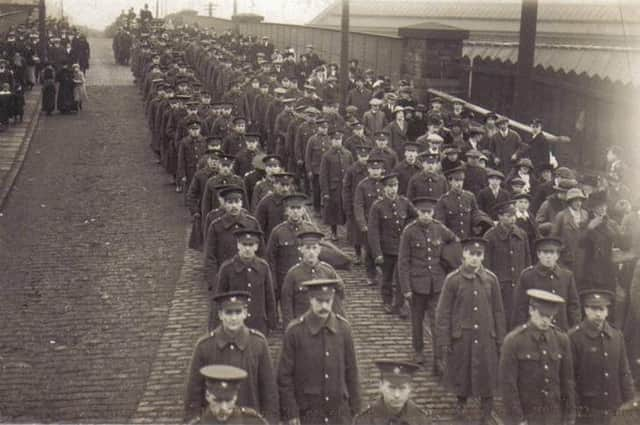Nostalgia column: Stories of local soldiers and families to be told..


And I shall continue to write of the devastating effects war had on the lives of local people, both on the battlefield and here at home, writes Margaret Watson.
Also to write about and thank all those local groups and individuals who have dedicated much of their time researching and writing books about them and the families they left behind.None more so than the history group of Our Lady and St Paulinus Church, Westtown, who wrote a book listing the names of all the men from the parish who gave their lives in both the First and Second World Wars.
Advertisement
Hide AdAdvertisement
Hide AdIncluded in their book is the story of two members of the church, John James Tighe, of Thornhill Lees, and James McDermott, of Westtown, who were two of the first men from Dewsbury to be killed in the First World War.
They were among the first to go to war when it broke out in August, 1914, and, like the rest of the country, believed it would all be over by Christmas.
Within weeks of 1915 dawning, two young men from Dewsbury had lost their lives and many hundreds more would follow in that year alone. These two men were among the first batch of soldiers to be sent to the Front, and they lost their lives within two days of each other. James McDermott was killed in action and is buried in foreign fields, and John James Tighe died from his wounds, and is buried in Dewsbury Cemetery.
Both men were professional soldiers and had served their country before war broke out, and both had worked at Kilner’s Glassworks, Thornhill Lees. Hundreds more men from Dewsbury would lose their lives that same year, and many hundreds more would also die in battle in the four years which followed.
Advertisement
Hide AdAdvertisement
Hide AdThe exact number of those who were killed is not yet known but local war historians believe that the number is far more than those named on the Dewsbury Cenotaph. At present there are 1053 names on the Cenotaph, but Dewsbury Sacrifices, of whom I wrote last week, believe the number could be as high as 1,500.
This voluntary group have been researching the names of those already on the memorial, and plan to continue searching for any missing soldiers whose names should be there.
A book in Dewsbury Library, produced by the old county borough of Dewsbury, only gives the names of those already inscribed on the memorial, and until now no-one has challenged that number.
The names presently inscribed there were only recorded a few years after the war ended, and only when the council had decided to erect a memorial to them.
Advertisement
Hide AdAdvertisement
Hide AdThe war ended in 1919, and the memorial wasn’t erected until five years after the end of the war.
Although John James Tighe did not die in action, the causes of his death were traceable to the exposure and hardships that he suffered in France during the opening stages of the war. He was aged 29. A professional solder, he had left the Army in the summer of 1914 after serving nine years in India as a regular soldier, and six weeks later he was called up to fight in France
.He experienced shellfire and German bullets at Mons, and at La Bassee he was buried for five hours by torn up earth until finally being released. Suffering from a crushed ankle and injured leg he was brought home and treated at Sheffield and Barnsley hospitals. But his illness grew worse and he was diagnosed with the same pneumonic trouble from which he was later to die.
John James was unmarried, and prior to the war, had obtained employment with Kilner Brothers, Thornhill Lees. He was given a military funeral, which took place at St Paulinus Church, conducted by Father Ennis. Standing nearly six feet tall, he was described as a splendid athlete who took part in all branches of sport. He was the popular captain of his company’s football team while serving in India, and was released by the War Office just two months before England declared war on Germany.
Advertisement
Hide AdAdvertisement
Hide AdBut late in July that year he was called for active service and left for the front early in August. His family were well known in Thornhill Lees, where his father, Patrick Tighe, was one of the founders of the Thornhill Lees Working Men’s Club.
James McDermott was the second Dewsbury boy to die in the January of 1915. He was 32, and was married but with no children. Not as much is known of him as John James Tighe, but he was a member of the second battalion Kings Own Yorkshire Light Infantry, and was killed in action at Wulvergham. He is buried at the Wulvergham-Lindenhoek Road Military Cemetery in Belgium, about three miles from the French border.
He was born in 1882 at Middle Road, Westtown, son of James and Catherine (nee Brear), McDermott. James lived at various places in Westtown, including Hanover Square, Princess Street and Boothroyd Lane. He married Mary Henry at St Paulinus Church, Westtown, in 1906, and had four siblings, Thomas, Ann, Mary and John And like John James Tighe, he worked at Kilner’s Glassworks, Thornhill Lees.
Both men are also remembered in the book ‘The Men of Our Lady and St Paulinus Church’, compiled by members of St Paulinus History Group.
Grateful thanks to Dewsbury Sacrifices for once again helping me to compile this article, and members of St Paulinus History Group. Also to Stuart Hartley for kindly loaning the photograph.